Google Nexus 4 and Nexus 10 Performance Preview
by Anand Lal Shimpi & Brian Klug on November 2, 2012 11:00 AM ESTGPU Performance
This section is particularly exciting because it's our first look at ARM's new Mali-T604 GPU in our standard mobile 3D performance suite. We've already seen the Nexus 4's Adreno 320 in action, but the Nexus 10's behavior here should be interesting to see.
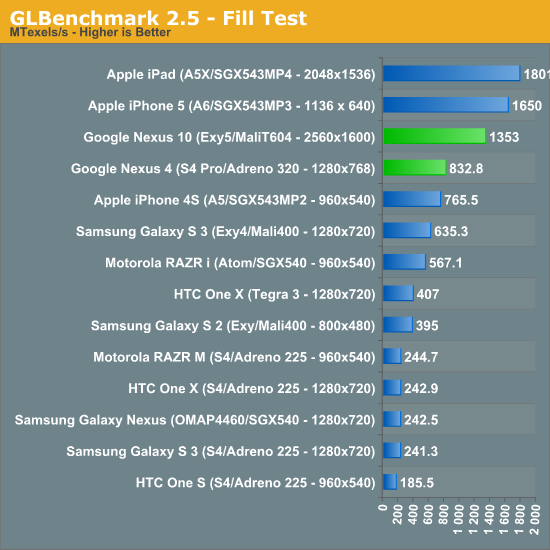
As far as raw fillrates are concerned, both Nexus devices do quite well here at their native resolutions. The iPad and iPhone 5 are both quicker, but we're still good gains over the previous generation of hardware - particularly for the Mali-T604. Compared to the Mali-400MP4 in the Galaxy S 3, we're seeing more than 2x the performance out of ARM's latest GPU.
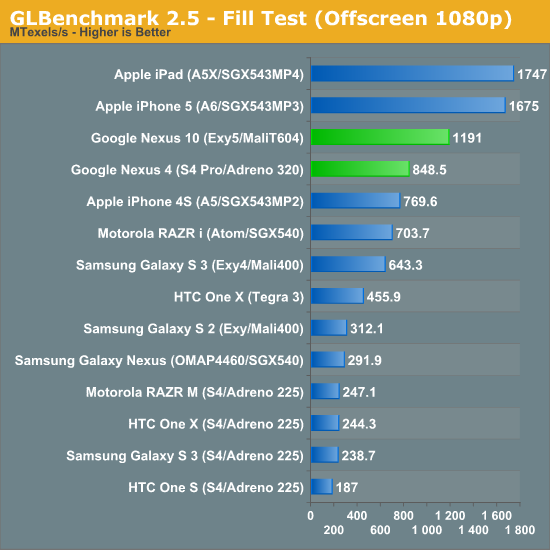
At normalized resolutions the standings don't really change.
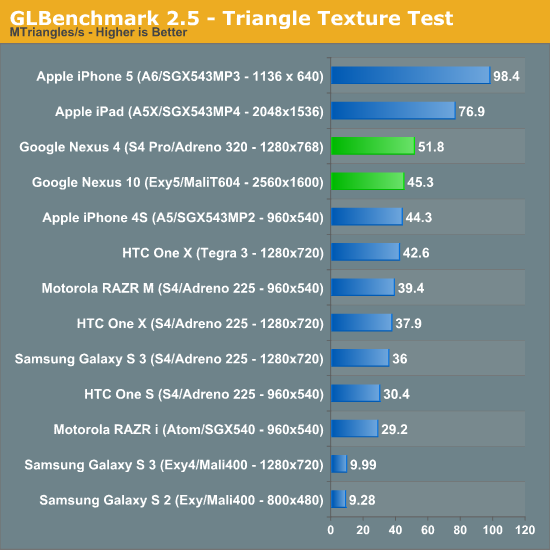
The T604 is ARM's first unified shader architecture, which gives it far more balanced pixel/vertex shader performance. The result is a more than 4x increase in triangle throughput compared to the Mali 400MP4. It's not enough to give the Nexus 10 the edge over the latest Apple devices, but it's a huge improvement over where ARM was in the previous generation. The Adreno 320 continues to be quite strong here as well.
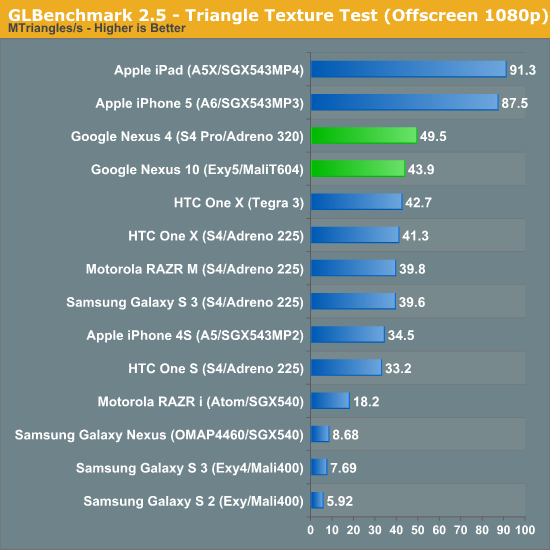
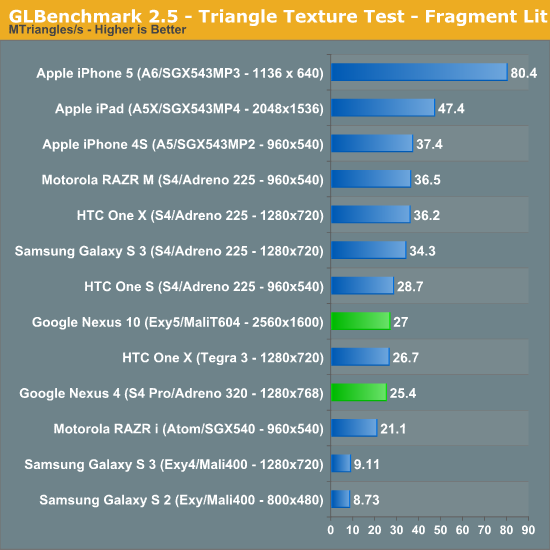
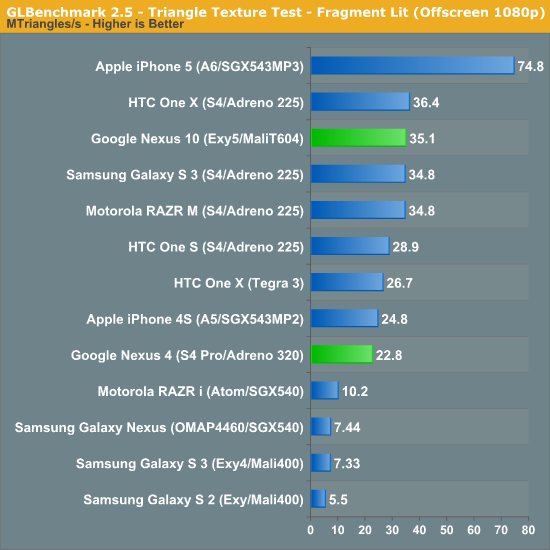
Once again we're seeing huge gains for the Mali-T604 compared to the Mali-400MP4. The Adreno 320 in the Nexus 4 actually performs worse than the Adreno 225 in older devices, possibly due to thermal throttling we saw on the Nexus 4 sample during periods of heavy load.
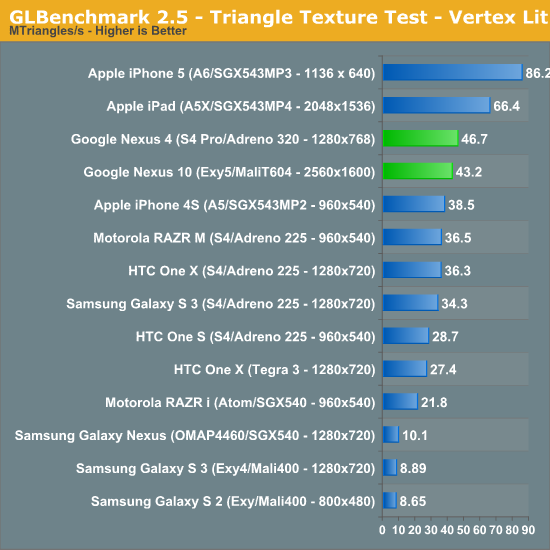
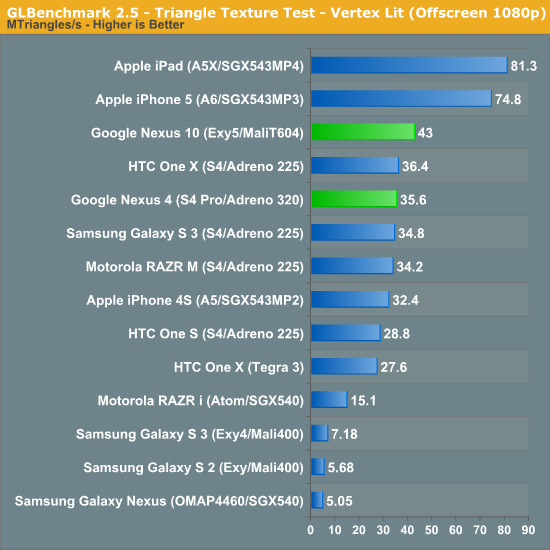
ARM shows the biggest gains here once again thanks to its move to a unified shader architecture. The Adreno 320 does ok here but it's really no better than the 225, I suspect there is some thermal throttling happening on the device.
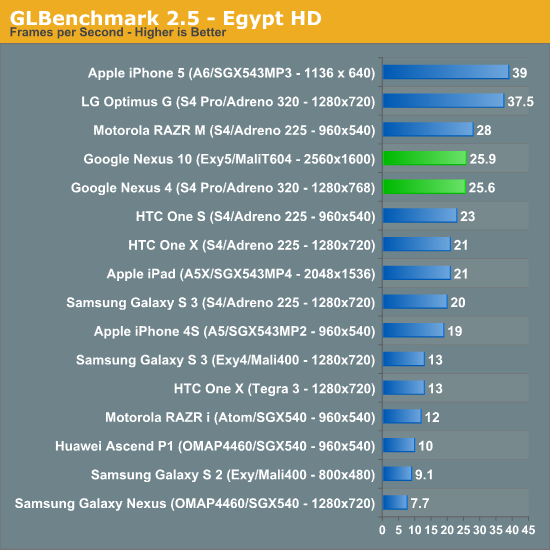
At native resolutions, the Nexus 10 and NExus 4 are both capable of putting out decent frame rates in Egypt HD. What this data tells us is they'll likely be able to run current and even some future titles, at native res, at 30 fps without much of an issue.
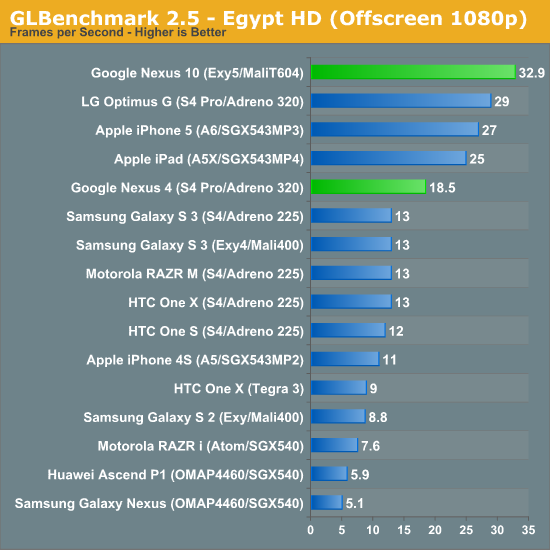
Normalize resolution and the Mali-T604 actually does very well here, setting a new performance record. Despite being based on the same hardware, the Optimus G is able to post a much higher score here than the Nexus 4. The explanation is simple: the Optimus G can't complete a single, continuous run of GLBenchmark 2.5 - the app will run out of texture memory and crash if you try to run through the entire suite in a single setting. The outcome is that the Optimus G avoids some otherwise nasty throttling. The Nexus 4 on the other hand manages to complete everything, but likely quickly throttles its clocks down due to thermal constraints. The Nexus 4 was really hot by the end of our GLBenchmark run, which does point to some thermal throttling going on here. I do wonder if the Snapdragon S4 Pro is a bit too much for a smartphone, and is better suited for a tablet at 28nm.
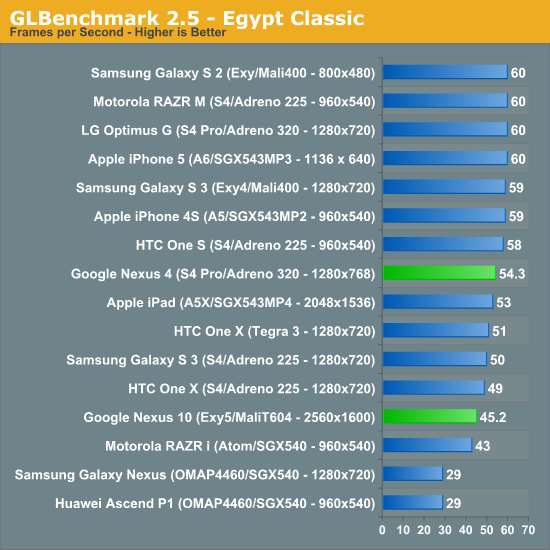
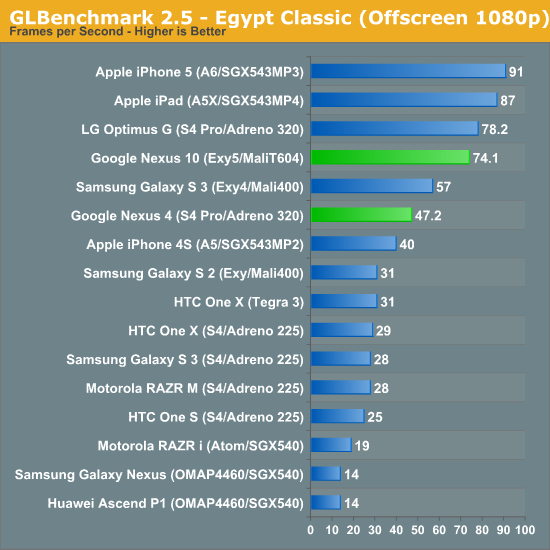
The Egypt Classic numbers are less interesting, but both platforms do well here.
Battery Life
We didn't have time to run through our entire battery life suite, but we do have some relevant results for the two devices. For smartphones, these are our latest web browsing battery life tests:
We regularly load web pages at a fixed interval until the battery dies (all displays are calibrated to 200 nits as always). The differences between this test and our previous one boil down to the amount of network activity and CPU load.
On the network side, we've done a lot more to prevent aggressive browser caching of our web pages. Some caching is important otherwise you end up with a baseband test, but it's clear what we had previously wasn't working. Brian made sure that despite the increased network load, the baseband still had the opportunity to enter its idle state during the course of the benchmark.
We also increased CPU workload along two vectors: we decreased pause time between web page loads and we shifted to full desktop web pages, some of which are very js heavy. The end result is a CPU usage profile that mimics constant, heavy usage beyond just web browsing. Everything you do on your smartphone ends up causing CPU usage peaks - opening applications, navigating around the OS and of course using apps themselves. Our 5th generation web browsing battery life test should map well to more types of smartphone usage, not just idle content consumption of data from web pages.
As always we test across multiple air interfaces (3G, 4G LTE, WiFi), but due to the increased network load we actually find that on a given process technology we see an increase in battery life on faster network connections. The why is quite simple to understand: the faster a page is able to fully render, the quicker all components can drive down to their idle power states.
All Android tests use Chrome and 5GHz WiFi unless otherwise listed.
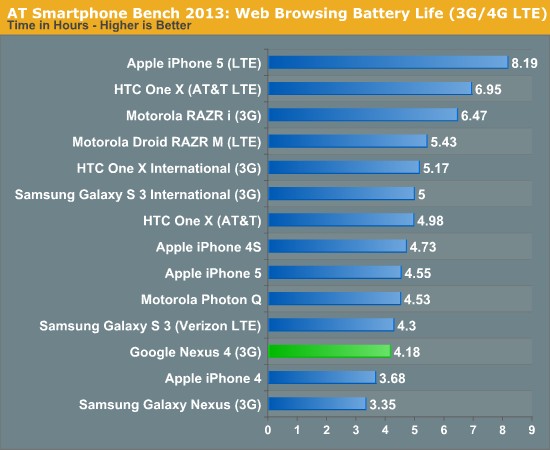
The Nexus 4 doesn't break any records for 3G battery life, it ends up relatively low on our list - even the Galaxy S 3 manages to do better here on 3G.

WiFi battery life is similar to the Galaxy S 3, but again it's not all that impressive compared to some of the other devices in this list.
Our tablet web browsing battery life test isn't directly comparable to the new smartphone tests, so we've got a separate chart for the Nexus 10:
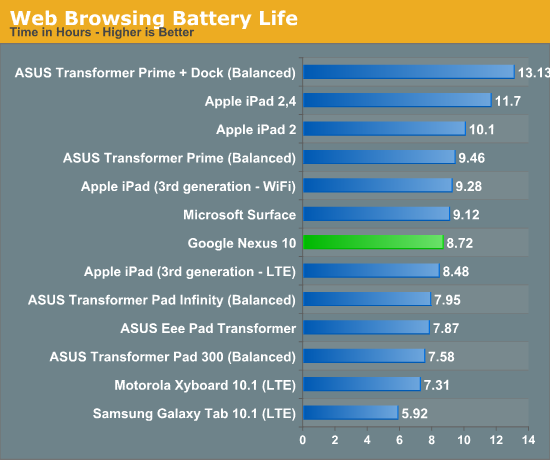
Despite driving a very high res panel, Google is able to deliver relatively competitive battery life with the Nexus 10. Battery capacity is around 80% the size of the 3rd gen iPad and battery life is around 93% of what Apple delivers here. Over 10 hours would be nice to have, but 8 hours of use in this test isn't bad at all. We'll have to do more testing to understand Exynos 5's power behavior a bit better, but so far it doesn't seem that the platform is all that bad from a power consumption standpoint. It remains to be seen how gracefully the Nexus 10 will handle being taxed heavier.
Display
We're still running our big display analysis routines on the new Nexus devices, but the brightness/contrast data below is a little teaser:
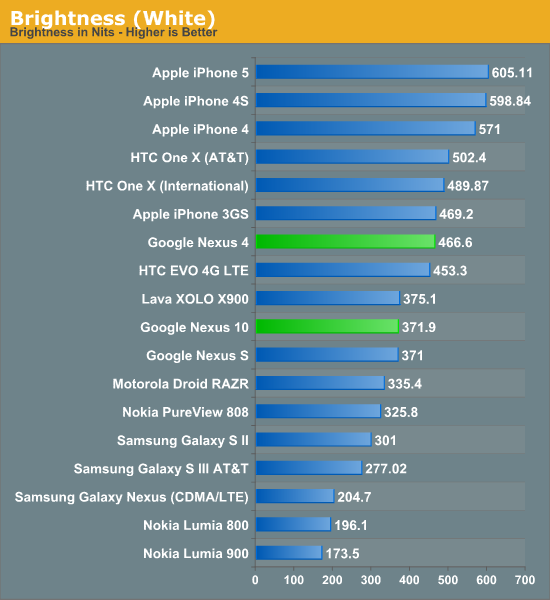
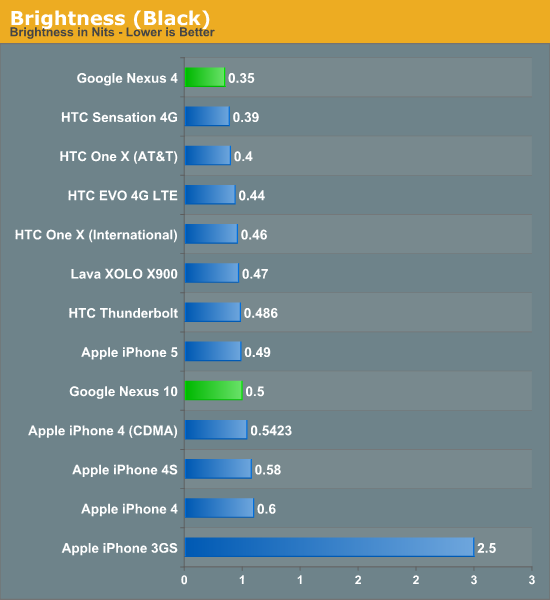
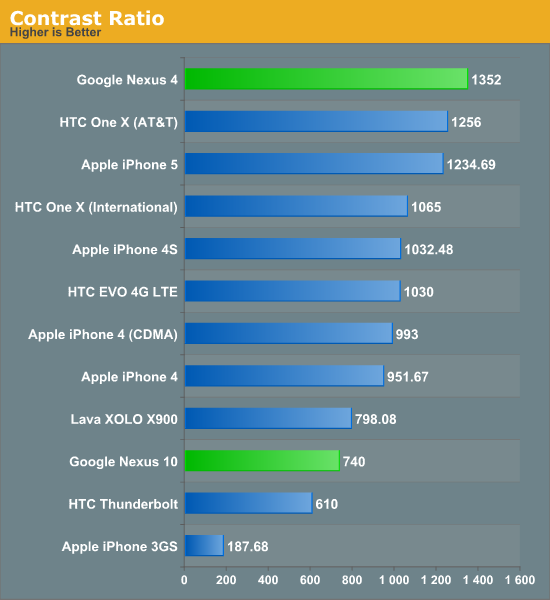
Final Words
We still have a lot of additional writing and testing ahead of us. Stay tuned for our full review of both devices!










244 Comments
View All Comments
UpSpin - Saturday, November 3, 2012 - link
The iPhone/iPad score almost double the numbers of their competitors in Offscreen- Fill test
- Triangle Texture Test
- Triangle Texture Test - Fragment Lit
- Triangle Texture Test - Vertex Lit
Yet in the HD Offscreen benchmark both the iPhone and iPad score averagely.
I think we can safely conclude:
Those Fill/Triangle Test are meaningless. So why on earth do you post them? Or tell us the use of them.
If a device scores exceptional in those, it still can deliver medioce 3D performance, so those benchmarks say NOTHING.
If I have a car with a motor which can spin 100.000 rpm if the tires are lifted in the air, but on the road, it can't spin faster than 1000rpm, you know what? Then the 100.000rpm in air is meaningless.
Because of the huge number of meaningless charts (Fill/Trinangle) in your preview they just make everything confusing, and make it hard to compare the real performance of the devices.
krumme - Saturday, November 3, 2012 - link
Agree. This kind of mess must stop now, its very difficult to interprete the results.Solution:
I would prefer, the method used in the recent cromebook where you compared in the same software platform. A very seldom straight review that i appriciated very much.
Meaningless benchmark with little resemblance to practical usage must be omitted.
I know it probably means less numbers and bm, but so be it. It will improve in time. I know it cost tons on money to develop propor independant benching. But the Anand own sdd bm suite was a huge step forward for evaluating ssd, and really made Anandtech stand out as hands down the best site for the ssd stuff. We need something of that caliber.
This nonsense just leads to wrong interpretations and buying decicions, and can influence the development in wrong ways, meaning less money for real development and more for technical marketing.
Krysto - Saturday, November 3, 2012 - link
Agreed, those numbers do seem pretty much useless. Even if the GPU's can go that high in those benchmarks, they're probably bottlenecked by something else in the system, which makes the extra performance in those specific benchmarks pointless, and this is why the iPad scores much lower in the "full graphics tests" like Egypt HD, etc.juicytuna - Saturday, November 3, 2012 - link
These graphs are getting abused all over the internet. I saw an article yesterday where the author used a solitary triangle texture test graph to show the iphone / ipads superior graphics performance over rivals Beggars belief really.I think Anandtech needs to educate its reader base more on what these low level tests actually mean and how they are rather meaningless in the context of real world performance.
Perhaps putting them into tables rather than giving them a pretty graph might help too.
Filiprino - Saturday, November 3, 2012 - link
Yep. The Nexus 10 although using a basic Mali T600, has a good score in the Egypt Benchmark.tytung - Sunday, November 4, 2012 - link
I don't think so.Cars with a higher hypothetical rpm in the air would almost certainly perform better than those that can't even perform well in the air.
BTW, iPad/iPhones are highly tweaked to perform well under real life circumstances and user experience.
-sandro- - Saturday, November 3, 2012 - link
How is it possible iPhones always win in 3G/WIFI web browsing battery life? Is it that difficult for Android to make a phone last 10 hours in wifi like Apples does?vision33r - Saturday, November 3, 2012 - link
Android was not optimized with hardware as well since Apple has full control of both hardware and software designs. Even Nexus Phones, Google does not do any hardware designs.They will never reach the hardware software intimacy that a company like Apple can achieve.
The gap will widen when hardware gets faster and become more power hungry and Apple will be even more efficient with their software than the rest.
Google needs to understand at some point they need to get involved in the chip and hardware design in order to maximize their software optimizations.
UpSpin - Saturday, November 3, 2012 - link
Then tell me how HTC was able to deliver such a good battery life (according to AT) whereas they used a smaller battery than the Nexus 4 does. One does not have to make his own processor to achieve a better battery life.The browser ratings are pretty bad, what AT did was a browser battery rundown. So page rendering was probably more CPU intensive on the Nexus 4 than on other smartphones. If the browser gets improved, so will the battery life, too.
Maybe their review unit is defective, too (overheating, low battery life, poor results compared to reviews like TheVerge)
And finally, you shouldn't forget, that Android allows any background tasks to be active. iOS not, with their 'pseudo multitasking'. This gives iOS a huge advantage (far easier process managment, less memory needed, less CPU ressources wasted) but the user suffers.
Still, the battery life of the Nexus 4 doesn't look great, and I doubt that those numbers are correct, especially because TheVerge praised the Nexus 4 battery life.
Would be interesting to see the battery life of the identical (yet according to AT much more powerful) LG Optmius G. if it's much better, than their review unit is broken and/or the browser in Android 4.2 is broken.
Jorange - Saturday, November 3, 2012 - link
Dear Anand and Brian.I am slightly worried that Anandtech is not treating all devices on a level playing field. You mention that the Optimus G could not complete the entire GLBenchmark test consecutively, as it crashed due to running out of memory or such like, so the benchmarks must have been run individually?, a far less taxing task than completing the entire benchmark in one run that Nexus 4 managed, hence the FPS were lower as the SoC hit thermal limits, which paints a poorer picture of the Nexus 4.
For the sake of openness and to dispel any talk of favoritism, could you please confirm whether the iPhone 5 / iPad GLBenchmark scores were the result of 1 serial run through the entire suite or multiple independent tests. I tried to run all test in one go on my Nexus 7 and it crashed, so if Apple devices can mange this feat, it would be cool to known the rationale for this, if not, then surely the Nexus 4 should be tested under the exact same methodology as any all other devices. Would you consider Linpack as an addition to your usual rigorous test suite.
Looking forward to your reply
Joe